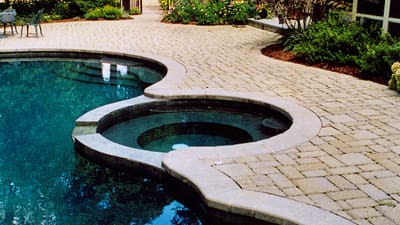 During the hot summer months in northern New Jersey, a swimming pool provides a great way to stay cool and enjoy the sunshine. It creates a relaxing atmosphere for entertaining family and friends on hot days and warm evenings. With good design and planning, a swimming pool can turn your backyard into a beautiful oasis.
During the hot summer months in northern New Jersey, a swimming pool provides a great way to stay cool and enjoy the sunshine. It creates a relaxing atmosphere for entertaining family and friends on hot days and warm evenings. With good design and planning, a swimming pool can turn your backyard into a beautiful oasis.
Swimming pool design has changed a lot over the past decade. Swimming pools are not just a plain rectangular shape with a white concrete bottom anymore. They are designed in various shapes and sizes with beautiful custom features that reflect the architectural style of the house. They incorporate the property’s natural terrain and surrounding landscape. Today, swimming pools are part of a customized plan that turns your backyard into an outdoor showplace.
Popular Swimming Pool Shapes
Pools can be custom made to fit your yard and specific needs. After you determine the appropriate size and location for your pool, it can be designed in a variety of custom shapes. Here are some of the most popular shapes for in-ground pools.
- Rectangle.
- Square.
- Round.
- Oval.
- Octagonal.
- Kidney.
- Figure Eight.
- L-Shaped.
- Grecian.
- Roman.
- Riviera.
The variety of custom swimming pool design shapes makes it easier to build your pool into your existing landscape. Whether your backyard is flat, hilly, sloped or terraced, there’s a shape that will compliment any home and property.
Swimming Pool Design Trends
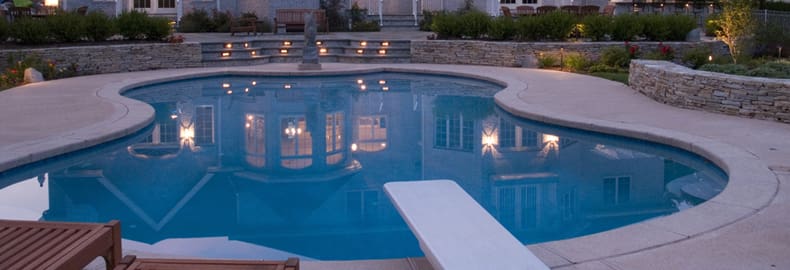
Although a swimming pool is a great investment that will increase property value, it’s expensive to build and install. Current trends show, however, that swimming pools are growing in popularity and demand in homes across the country. The swimming pool industry is seeing renewed popularity in the backyard pool. One reason for this renewed interest is the creative pool designs and features now available to homeowners. Take a look at some of the hottest swimming pool design trends for 2014.
Natural Pools
Natural pools take advantage of the natural terrain and landscape that surrounds the pool area. The goal is to build a pool that fits naturally into its surroundings so it looks like it’s meant to be there. A natural pool uses no chemicals or devices that sterilize or disinfect the water. It’s all done through biological filters that are provided by natural plants used as part of the pool environment. Natural swimming pools are usually divided into two areas – the swimming zone and the regeneration zone.
- Swimming zone – The part of the pool used for swimming. It can be designed in any shape with various accent features.
- Regeneration zone – A connecting pool that’s filled with specific plants and flowers that act as a filtration system for the swimming pool. It resembles an adjacent water garden or pond, but it provides natural biological processes to keep the swimming pool water clean.
The swimming zone and regeneration zone are physically separated by a wall or barrier. Both zones must be equal in size to create sufficient purification for the swimming pool. The swimming zone can be used immediately after construction, but the regeneration zone typically takes two or three years to reach a stable filtration level.
Once a stable filtration level is reached, natural pools require a lot less maintenance than conventional swimming pools. A natural swimming pool design creates an eco-friendly backyard environment that’s in total harmony and balance with your existing landscape.
Infinity Pools
Infinity pools are built with a vanishing or disappearing edge creating an illusion that the water extends beyond the pool. These pools create a stunning visual effect of infinite space, especially when they are built with a lake or ocean view. In this situation, the infinity edge looks like it merges with the water in the distance creating an endless body of water. The infinity edge of the pool actually ends about ¼ inch below the water level. A barrier is created that spills the pool water into a catch basin that pumps it back into the pool.
Infinity pools are expensive to build because they require a lot of structural support, mechanical hydraulics and architectural design details. When the pool is built in certain locations like cliff overhangs, mountainous or deep slopes or beachfront properties, a geological survey is usually required to make sure the landscape will support a stable structure. The primary costs of infinity pools are in the foundation and support systems. Although many infinity pools are designed to incorporate a water view, they are just as beautiful in a terraced back yard or natural setting.
Geometric Shapes
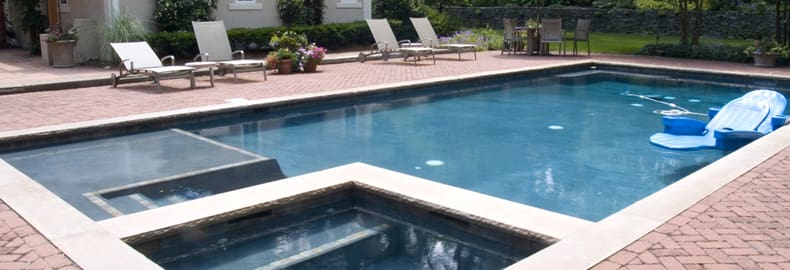
Swimming pools with geometric shapes have become very popular over the last several years. Rectangular, square, round, oval, octagonal and L-shaped pools are in great demand in 2014.
These geometric shapes tend to fit traditional backyard spaces, especially in urban areas, much better than some of the more elaborate designs. For contemporary architecture and homes with smaller yards, these shapes take up less of the yard and allow more room for other outdoor features such as outdoor kitchens, patios and decks, fountains and landscaping. Geometric swimming pool design also allows more space for custom pool built-ins like steps, sloping entries, seating, swim-up bars, waterfalls and tanning ledges.
Geometric-shaped pools provide crisp edges that compliment formal and contemporary architecture. They can be built using one geometric shape or a combination of shapes within one pool design. They can also be built with more than one level, such as a terraced pool, that offers different water depths and functions for each level.
Exercise Pools
We are seeing an increase in popularity and demand for exercise pools in 2014. Exercise pools, also known as lap pools, are a popular swimming pool design trend around the world. As space becomes a commodity in urban areas, these smaller pools are easier and cheaper to build. There are two basic types of exercise pools:
- Lap pools – A lap pool is long and narrow with straight edges. It can be built to any desired length to fit space requirements. Although the shape is a simple rectangle, it can be built with an infinity edge, connecting spa or custom features.
- Exercise pools – A true exercise pool is built with a resistance jet at one end of the pool that creates a current much like a small wave. The resistance jet allows you to swim in place without actually going from end to end of the pool.
Exercise pools and lap pools can be installed in-ground or above ground and indoors or outdoors. They offer a lot of versatility with lower costs and maintenance. They can be insulated, heated and designed to accommodate different water depths. Exercise pools and lap pools may be a trend that’s popular for years to come. They offer homeowners a great way to stay fit within small budget and space requirements.
Salt Water Pools
Salt water pools are gaining in popularity as an option to conventional pools. They are treated with common salt instead of chlorine. The salt actually converts into chlorine through an electrolysis process that keeps the water sanitized. Salt is added to the water on a regular basis, but much less frequently than chlorine requirements in a regular pool. Maintenance is reduced by the salt additive.
Salt water pools have many health advantages. There is no chlorine smell or harmful chemicals in the pool. Salt water is much better for your skin, hair and eyes than chlorine. It does not dry out the skin and mucous membranes like harsh chemicals. In general, swimming in a salt water pool is like swimming in a saline solution. It leaves the body feeling soft and refreshed.
Hot Tubs
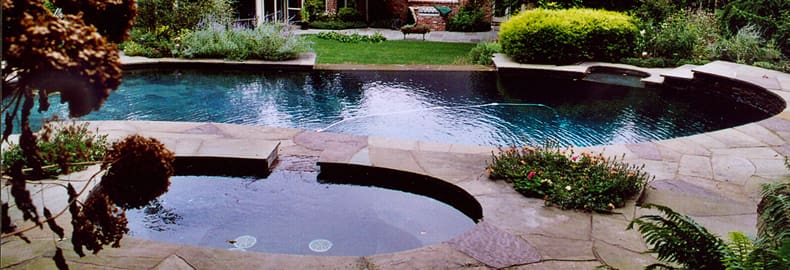
Attaching a hot tub to the swimming pool is a popular trend with today’s homeowners. Many homeowners are requesting an attached hot tub as part of their custom swimming pool design. Attached to one end or one side of the pool, a hot tub provides a great way to relax tired muscles after a swim. It also adds versatility and useful features to the pool. New hot tubs offer controllable water jets, LED lighting and infinity edges. A hot tub attached to your pool will increase the property value of your home even more.
Glass-Tiled Swimming Pools
One of the hottest swimming pool design trends for 2014 is the use of glass tiles. They are quickly replacing ceramic and porcelain tiles that have typically been used in most swimming pools for many years. Glass tiles are very strong. They are much harder than ceramic tiles which makes them difficult to crack or break. They are impervious to some of the problems caused by harsh chemicals and chlorine used in the pool.
Glass tiles come in a variety of shapes, sizes and beautiful colors. They can be used as a border for the pool ledge, inside the pool or around the hot tub. The natural iridescent qualities of glass tiles create a beautiful shimmering glow as it reflects the water in the pool.
Water Features
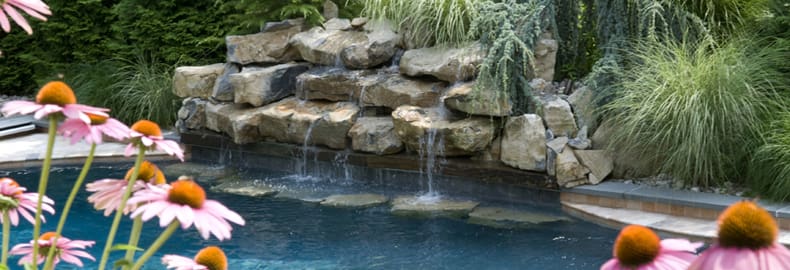
Custom water features are popular trends for today’s pools. They create an area of interest and add a unique ambiance to the pool area. Here are some of the hottest features that homeowners want in 2014.
- Waterfalls – Waterfalls can be created to flow over pool ledges, attach to walls and structures or natural landscape features in the yard. They create a soothing sound and provide areas of interest for swimming or relaxing.
- Fountains – Pool fountains can be placed within the pool area or in an adjacent area. They add natural sounds and come in a variety of styles to compliment your pool design.
- Bubblers and Jets – Bubblers and jets add interest to the pool by creating movement in the water.
- LED Lighting – Pool lighting provides safety and ambiance for swimming at night. Spotlights, uplights and floodlights are great for lighting pathways and poolside landscaping. Fiber optic underwater lights come in clear and different colors. They can add dramatic accents and fun colors to your pool.
Outdoor Patio Materials
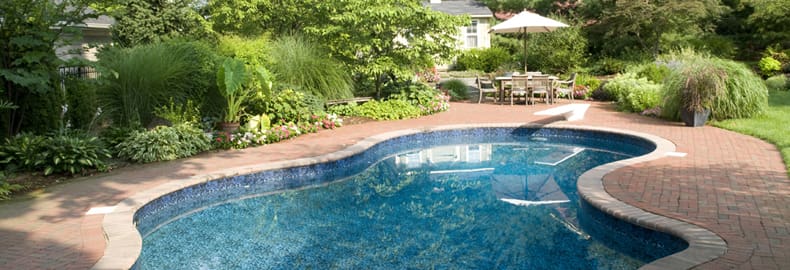
Natural stones like travertine, limestone, flagstone and slate are still leading the way in popular swimming pool design trends for pool surrounds and outdoor patio materials. Their natural aesthetic appeal and ease of maintenance is hard to beat.
Most of these stones also have a smooth surface with a natural matte finish that provides much needed slip resistance around a swimming pool. Brick pavers are a good option for northern New Jersey areas that get a lot of rainfall. They have a rustic traditional appeal and allow for good drainage.
One trend that’s emerging quickly with contemporary architecture is wood decking. Woods like redwood, teak and cedar weather naturally to beautiful shades of gray and brown. Used around a pool, wood has to be treated with a water resistant sealer to prevent warping or rotting. Although it has more drawbacks than natural stone, the look is quite stunning.
Final Thoughts
As you can see, there are plenty of swimming pool design trends for 2014. No matter what your preference is, it’s important to work with a swimming pool contractor to help your dream come to life!
